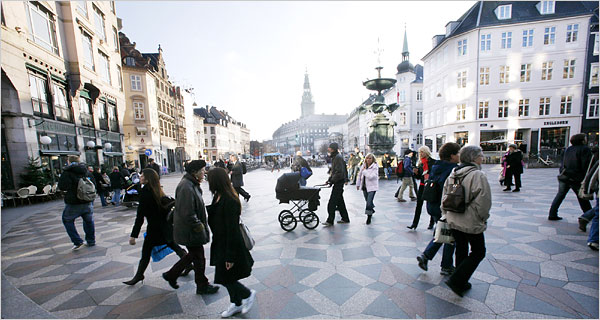Compare and contrast the Copenhagen transit system to another one you know well. Discuss what you believe are strong elements in Copenhagen's public transportation and the areas you think the city could improve upon. What does Copenhagen do that might be applicable to your city? Does the city you chose have any examples or ideas that Copenhagen could adopt? Which transit system to you feel safer riding?Considering that I use the Copenhagen transit system practically every day, it is certainly my most familiar public transportation system. Feeling comfortable on the train, bus, and metro, I appreciate the safety, cleanliness, and dependability that all three provide. When compared to the other transportation system I know, the Boston commuter rail and train system, Copenhagen's public transportation appears newer, better designed (logistically, aesthetically, and structurally), and easier to navigate. Nevertheless, I can think of a suggestion or two for Copenhagen that I see working well in Boston.
A few of the things I appreciate about the Boston train system that could be employed in Copenhagen: - You can buy plastic cards for the train that you can refill at your leisure. These cards last indefinitely and cut down on waste. They can also be filled monthly at a reduced cost for people who use the trains regularly. They fit into a wallet and so are easy to use and carry. I think these cards make much more sense than the kilp cards that end up littering bus stops and train platforms, and the navy blue passes that need to be replaced somewhat regularly. The cards, called Charlie cards, are simply more efficient.
- The trains in Boston and its surrounding metro areas are color coded. You could never get onto the wrong train because you would immediately tell as the train pulls into the station whether or not it's the green line or not.
 The old, yet iconic Boston Green Line
The old, yet iconic Boston Green Linehttp://lauramcwilliams.files.wordpress.com/2009/08/bostongreenline.jpg
- Express trains or trains traveling further are clearly marked and not easily confused with other local trains. Most often they are on entirely different platforms. This is not always the case in Copenhagen, especially at Nørreport and I have known several people who have accidentally rode these trains far out of the city without an opportunity to get off.
- Public transportation is hands down less expensive in Boston. Perhaps, Copenhagen has made it more expensive because they are trying to encourage people from biking instead. Nevertheless, Copenhagen's prices are steep. Then again, the price of everything in Copenhagen is steep.
That said, I think there many more things that Boston could learn from Copenhagen: - Many of the trains and stations in and around Boston are simply old and worn down. If the city could invest more into the design an upkeep of both the trains and stations, I'm sure more people would be willing to take them.
 Dark and dingy inside of a typical Boston train platform http://www.universalhub.com/images/2009/dtxsmoke.jpg
Dark and dingy inside of a typical Boston train platform http://www.universalhub.com/images/2009/dtxsmoke.jpg- One of the things I was most interested in about Copenhagen's stations is their use of light and elimination of dark corners. Making sure their stations are safe places, even at night, makes such a difference to passengers. I have never once felt unsafe in a Copenhagen train station but I am sure there are many stations in Boston that I simply would not want to be at night.
- Boston stations do not show waiting and arrival times for the trains. Many of them do not even have a schedule of when the trains are supposed to arrive. I think adding these few little things would make the train waiting process so much better.
 Copenhagen Metro Station, clean, well lit, and easy to navigate because of its arrival time displayhttp://farm4.static.flickr.com/3239/3151069958_16078030e8.jpg
Copenhagen Metro Station, clean, well lit, and easy to navigate because of its arrival time displayhttp://farm4.static.flickr.com/3239/3151069958_16078030e8.jpg- Although there is a commuter line that goes from Boston to outlying suburbs, many areas simply have no access to public transportation. Adding bus lines that reach more suburban areas would reduce car traffic. Considering that traffic in Boston is a real problem with it's continuous construction projects and confusing old roads, these busses would be a great asset. Of course, these busses would have to be clean and reliable so that commuters would want to ride them.
- Proving wireless internet for commuters is an excellent service that the Copenhagen transit system offers its commuters. Overall, their use of technology is something Boston could learn from, such as the text messages commuters can receive when their train or bus is coming.






 Dark and dingy inside of a typical Boston train platform http://www.universalhub.com/images/2009/dtxsmoke.jpg
Dark and dingy inside of a typical Boston train platform http://www.universalhub.com/images/2009/dtxsmoke.jpg Copenhagen Metro Station, clean, well lit, and easy to navigate because of its arrival time display
Copenhagen Metro Station, clean, well lit, and easy to navigate because of its arrival time display Space taken up by St. Pancras Station
Space taken up by St. Pancras Station Your Walking Tour Map, Thanks to Google Maps
Your Walking Tour Map, Thanks to Google Maps Amagertorv stone paving, designed by Bjørn Nørgaard http://ytiffanie.files.wordpress.com/2009/04/amagertorv.jpg
Amagertorv stone paving, designed by Bjørn Nørgaard http://ytiffanie.files.wordpress.com/2009/04/amagertorv.jpg Pictoform system, deigned by Knud Holscher
Pictoform system, deigned by Knud Holscher Nespresso Cartridges - One used for each cup of coffee http://www.singleserveespresso.com/pictures/NespressoCapsules.jpg
Nespresso Cartridges - One used for each cup of coffee http://www.singleserveespresso.com/pictures/NespressoCapsules.jpg